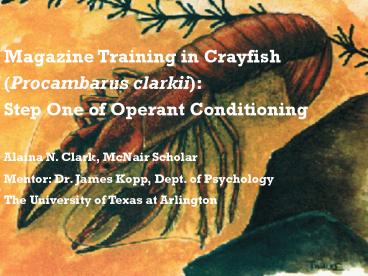Magazine Training in Crayfish PowerPoint PPT Presentation
1 / 19
Title: Magazine Training in Crayfish
1
Magazine Training in Crayfish (Procambarus
clarkii) Step One of Operant Conditioning
Alaina N. Clark, McNair Scholar Mentor Dr. James
Kopp, Dept. of Psychology
The University of Texas at Arlington
2
- Research Problem
- Benefits of Animal Behavior Research
- Literature Review
- Thesis Hypotheses
- Why Invertebrates?
- Why Procambarus clarkii?
- Experimental Design
- Results
- Future Studies
3
Research Problem
At risk
- Government academic funding for research
teaching involving vertebrate animals as
research subjects
Due to
- Public criticism of vertebrate animal testing
- Escalating per diem costs to maintain animals
kept in the lab
Without external funding
- Educational institutions may not be financially
capable
- Eliminate research programs using vertebrate
subjects
Current importance
- Develop a reliable replacement for vertebrate
model in behavior studies
- Promote continuance of animal behavior research
- Insure a smooth transition to new model
4
Benefits of Animal Behavior Research
- Provides research experience to students
- Development of a Behavior Analysis repertoire
Lab animal use for the function of education is
essential for students to become skilled at
conducting research (National Institutes of
Health NIH, 2002).
- Contributes systematic data
- Has multidisciplinary applications
- Comparative analysis
- Examines one species as a model for another
- Multidisciplinary Applications
- Psychology
- Biology
- Trend in behavioral studies
- Ethology (study of animal behavior in natural
habitat) - Controlling invasive species of crayfish
5
Literature Review
- Past studies involving crustaceans investigated
the physiological mechanisms of the functions of
learning (Corning Lahue, 1972) - There is limited data concerning learning in
invertebrates or suitable tests designed to
investigate it (Lahue, 1975) - Lack of systematic data does not indicate lack of
ability (Dunham, 1983) - Several studies have examined invertebrate
learning capabilities involving aversive
techniques, such as shock, low pH, predatory
chemical cues, or photo-sensitivity. (Chow
Leiman, 1972 France, 1985 Huggins Yerkes,
1903 Kawai, Kono, Sugimoto, 2003 Stafstrom
Gerstein, 1977) - Most pertinent comparison Dews (1959)
observance of lever-pulling as a function of
reinforcement in the octopus.
6
Thesis
We examined the viability of using crayfish
(Procambarus clarkii) to supplant the vertebrate
model in applications of modifiable behavior,
beginning with the establishment of magazine
training.
7
Hypotheses
Crayfish possess the aptitude to effectively
participate in replace the vertebrate model in
operant conditioning studies.
We expected the subjects to emit food-taking
behavior under the reinforcement contingency with
reduced response rates as a function of number of
sessions.
8
- Why Invertebrates?
- Satisfy the Replacement approach to humane
animal research (NIH, 2002) - Possess ability to alter their behavior to
environmental variations - More economical to use than current rat pigeon
models in acquisition, maintenance, utilization
- Invertebrates
- Inexpensively obtained from
- Local seafood markets
- Pet distributors
- Collected from natural habitat
- Less cost daily maintenance
- No per diem costs
- Care by professors or students
- Non-human vertebrates
- Costly to obtain from
- Educational providers
- Professional breeding labs
- Expensive daily maintenance
- Per diem costs per animal
- Salary of certified veterinary tech
- Use approved protocol by institutional
research compliance committee
9
- Why Procambarus clarkii?
- Semi-terrestrial lifestyle allows innovative
experimental designs (Krasne, 1973) - Wet or dry preparations (Reese, 1983)
- Can manipulate their appendages in precise ways
to form behaviors (Krasne, 1973 Reese, 1983) - Can survive in squalid conditions (Huner, 1988
Holdich Lowery, 1988) - Less demanding to care for than other species
- Appropriate for use in classrooms (Holdich
Lowery, 1988)
10
Operant Conditioning
Discriminative Stimulus
Response
Reinforcing Stimulus
11
Useful Applications of Operant Conditioning
- Behavior Modification
- Developmentally disabled autistic persons
- Toilet training
- Spoon-feeding
- Speech acquisition
- Schools correctional facilities
- Disciplinary programs
- Training
- Pets
- Friends family
12
PELLET DISPENSER
PIGEON KEYHOLE
MAGAZINE
SWITCH
13
MAGAZINE
14
Experimental Design
- 6 male crayfish (Procambarus clarkii) under
food deprivation - fed sinking shrimp pellets once daily
- Observed during 16 magazine training sessions
- Target behavior food-taking from food
receptacle, or magazine - 10 minute habituation to experimental
environment during the first 2 to 3 sessions - Magazine training
- Experimenter manually issued food reinforcement
(approximately 2 to 3 1-mg shrimp pellets)
whenever subject had taken food, then re-located
to different locations - greatest distance facing away from magazine
- submerged in water facing toward magazine
- click sound central discriminative stimulus
correlated with the availability of food (Denny,
1970)
15
Performance of Subject 5
Sessions 1-16
Negatively accelerated trend of decreased
response latencies
Response latencies in seconds as a function of
successive reinforcements
16
Performance of Subject 5
Sessions 1-16
Positively accelerated trend of increased number
of reinforcers earned
Number of reinforcers per subject during each
session
17
Partially Supporting Our Hypothesis, The Results
Suggest
Improved skill with experience Capability to
perform under more complex reinforcement
contingencies Increased performance with further
magazine training sessions Potential for
shaping operant behavior in crayfish
18
Future Studies
- Dry environment
- Maintain subjects at different deprivation levels
- Feed smaller amounts of food daily
- Shape an operant response keyhole- or
bar-pressing - Extinguish the response
- Provide no reinforcement for previously
reinforced response - Establish a response under other schedules of
reinforcement
19
Acknowledgements James Kopp, PhD, BCBA,
Mentor, dept. of psychology The McNair Scholars
Program Staff, Especially Sara Skiles DuToit Dee
Rodgers, Research Assistant Susan Crouch,
Research Assistant Richard Crouch,
Inventor/Machinist Robert McMahon, PhD, Dept. of
Biology Valerie Woodard, Dept. of
Biology Jennifer Fernandez, Dept. of Biology

